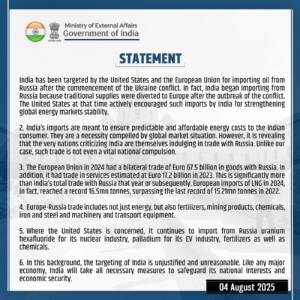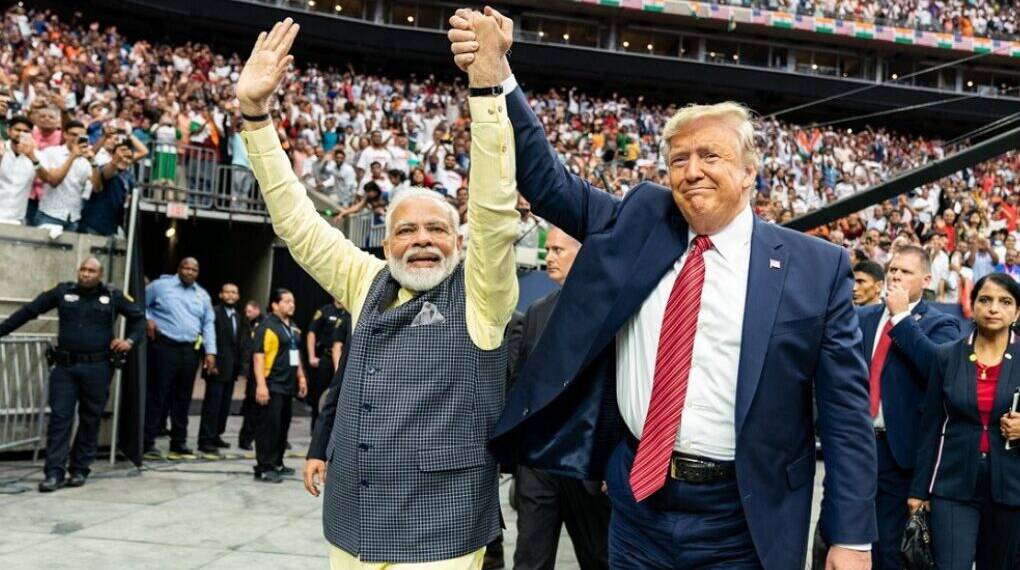In an escalating diplomatic standoff, U.S. President Donald Trump has launched a sharp attack on India over its continued purchase of Russian oil, threatening to impose substantial tariffs on Indian goods and accusing New Delhi of “funding the Russian war machine.” Trump’s remarks, posted on his social media platform Truth Social, have sparked outrage in India, which has described the targeting as “unjustified and unreasonable.”
As the rhetoric intensifies, the dispute exposes not only the fragility of U.S.-India trade relations under Trump but also deep contradictions in America’s own dealings with Russia, raising serious questions about fairness, consistency, and geopolitical double standards.
Trump’s Accusations: India Enriching Russia?

On July 31, Trump posted:
“India is not only buying massive amounts of Russian oil, they are then, for much of the oil purchased, selling it on the open market for big profits… They don’t care how many people in Ukraine are being killed by the Russian War Machine.”
He warned that the U.S. would “substantially raise the tariff paid by India to the USA,” suggesting punitive economic measures targeting Indian exports, from apparel and footwear to pharmaceuticals and copper.
This isn’t Trump’s first instance of blaming other countries for America’s global policy challenges. But in this case, his claims have drawn immediate fire from Indian officials and analysts alike — not only for their factual inaccuracies, but also for hypocrisy in light of America’s own Russian imports.
India’s Response: “Unjustified and Hypocritical”
India’s Ministry of External Affairs (MEA) issued a strong rebuttal, stating:
“India has been targeted… for importing oil from Russia after the Ukraine conflict began. In fact, India began importing from Russia because traditional supplies were diverted to Europe.”

Indian External Affairs Minister S. Jaishankar reiterated that India’s energy policy is driven by national necessity, not politics, adding:
“We live in complicated and uncertain times. A collective desire is to see a fair and representative global order, not one dominated by a few.”
India emphasized that its purchases of discounted Russian oil were intended to protect Indian consumers and maintain economic stability amid volatile global prices — a position it has maintained since the war in Ukraine began in 2022.
Moreover, the MEA called out the U.S. and European Union for continuing their own trade with Russia, highlighting a stark double standard.
The American double standard: Rising Imports from Russia
Despite heavy sanctions and public condemnation of Russia, the United States has quietly increased its own imports from Moscow in 2025.
According to data from the U.S. International Trade Commission:
U.S. imports from Russia rose 23% year-on-year in the first five months of 2025.
Imports included $806 million in fertilizers, $596 million in uranium, and $878 million in palladium — all essential for U.S. agriculture, nuclear energy, and electric vehicle industries.
This increase comes even after a 2024 ban on enriched uranium, which still allows waivers until 2028.
In stark contrast to Trump’s rhetoric, the U.S. has been benefiting from its trade with Russia even as it pressures countries like India to halt theirs.
The Indian government rightly pointed out that U.S. and European trade with Russia in 2024 far exceeded India’s, with the EU importing goods worth €67.5 billion and services worth €17.2 billion from Russia. India’s trade was a fraction of this amount — and based on pressing domestic needs, not luxury.
Former US Envoy Defends India
Adding fuel to the fire, a video of former U.S. Ambassador to India Eric Garcetti has gone viral on social media, where he states:
“They [India] bought Russian oil because we wanted somebody to buy it — at a price cap. It wasn’t a violation — it was the design of the policy.”
This candid admission exposes the coordinated strategy behind India’s oil imports, undermining Trump’s accusations and reinforcing India’s claim that it was fulfilling a global stabilizing role, not profiteering off war.
Trade Tensions and Economic Fallout
The fallout from Trump’s tariff announcement has rattled Indian exporters, particularly in labor-intensive industries such as:
Textiles
Leather goods
Footwear
Pharmaceuticals
These sectors rely heavily on the U.S. market, and a 25% tariff could wipe out thin margins, potentially triggering job losses and disrupting supply chains.
Interestingly, Trump’s post suggested some waivers would be granted, likely in strategic sectors like smartphones and pharmaceuticals, where the U.S. depends on Indian exports. This selective pressure tactic is being seen as a negotiating ploy — using trade as a weapon to influence India’s geopolitical stance.
The Geopolitical Game: Ukraine, NATO, and Trump’s Strategy
Trump has repeatedly criticized the U.S. role in NATO expansion and even blamed the war in Ukraine on the West’s push to include Kyiv in the alliance — a position that has drawn praise from Russian officials.
Now, Trump is trying to end the war on his own terms — using tariffs and trade pressure to choke off Russian revenue by targeting its remaining trading partners, including India and China.
But India has refused to be pushed into a Western-centric bloc, choosing instead to maintain strategic autonomy and diversify its global partnerships.
Prime Minister Narendra Modi, speaking in Varanasi over the weekend, reaffirmed India’s economic priorities:
“India is on its way to becoming the world’s third-largest economy. We must safeguard our economic interests amid global uncertainty.”
A Diplomatic Flashpoint or Political Posturing?
The Trump vs India standoff is more than a trade dispute — it’s a window into a changing global order, where countries like India are no longer willing to be lectured or coerced by Western powers acting in bad faith.
Trump’s threats may play well with certain domestic audiences, but on the global stage, they expose a deeper issue: the disconnect between American rhetoric and American reality.
As India pushes back with confidence and clarity, the world is watching:
Will this turn into a full-blown trade war, or is it just another round of political theatre?








